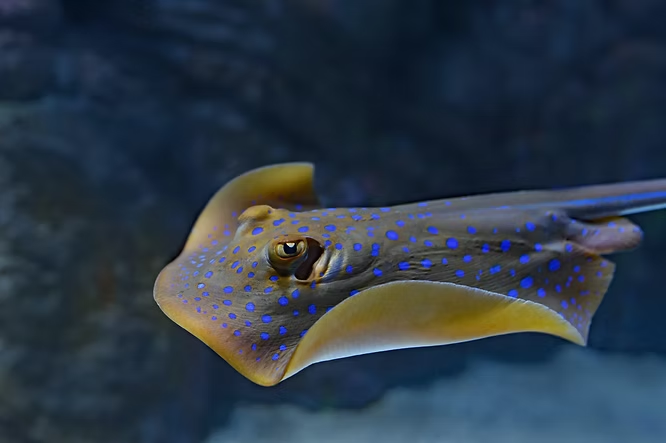Description and Behavior
The blue-spotted ray (Taeniura lymma), described in 1775, is a visually striking stingray recognized by its oval elongated body adorned with vivid blue spots and distinctive blue side-stripes along its tail. Its snout is rounded, while the disc features broadly curved corners. The short, tapering tail is less than twice the body length when intact and includes a broad caudal finfold extending to the tip.
Unlike many stingrays, this species lacks large thorns but has a line of small, flat denticles running along the midback of adults. Typically, a single medium-sized stinging spine is positioned further from the base of the tail compared to most rays. Coloration varies from gray-brown, yellow, or olive-green to reddish brown on the dorsal side, with a clean white ventral underside. Blue-spotted rays can grow up to 70 cm in length.
World Range and Habitat
Blue-spotted rays are widely distributed across the Indo-West Pacific. Their range stretches from the Red Sea and East African coasts to the Solomon Islands, reaching north to southern Japan and south to northern Australia.
They inhabit coral reef environments at depths of up to 20 meters. Unlike many stingrays, they are only rarely found buried in sand, preferring instead to move actively among reef structures where food and shelter are readily available.
Feeding Behavior
Feeding habits of the blue-spotted ray are both fascinating and social. During rising tides, they gather in groups and migrate into shallow sandy flats where they feed on mollusks, worms, shrimps, and crabs. When the tide recedes, they disperse to seek refuge beneath rocky ledges, in caves, or within the reef’s protective crevices. This daily rhythm helps them balance access to food with protection from predators.
Life History
Reproduction in the blue-spotted ray follows an ovoviviparous pattern. Mating typically involves distinct pair formation accompanied by a close embrace. Females are capable of bearing up to seven young in a single reproductive cycle.
Ovoviviparity means that eggs are retained inside the female’s body within a brood chamber, where embryos develop nourished by yolk sacs rather than a placenta. After hatching within the uterus, the pups are born fully formed and independent. This reproductive strategy, also called aplacental viviparity, provides greater protection for developing young and increases their chances of survival in reef ecosystems.
Together, their vivid appearance, coordinated feeding, and fascinating reproductive strategies make the blue-spotted ray a charismatic and ecologically important inhabitant of Indo-Pacific coral reefs.

